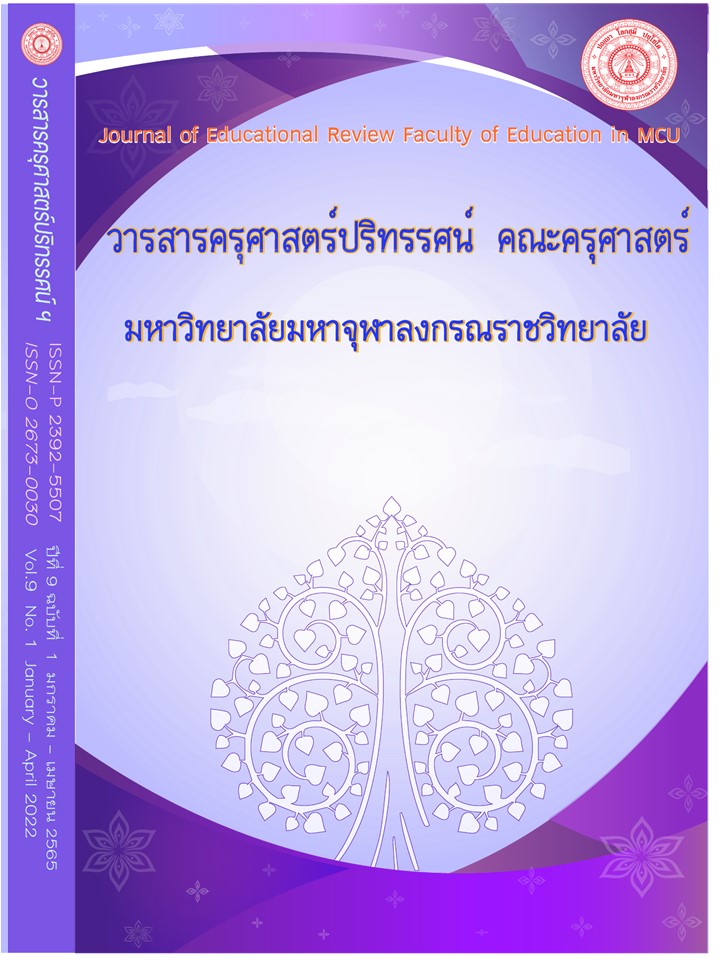A LEARNING MANAGEMENT MODEL IN THE CRISIS OF COVID-19 USING THE INFORMATION TECHNOLOGY FOR SCHOOLS, CHAINAT PRIMARY EDUCATIONAL SERVICE AREA OFFICE
Main Article Content
Abstract
This research aimed to develop and assessment of the learning management pattern efficiency during the COVID-19 pandemic. The information technology for educational institution under the Chainat primary educational service area was used which contained four steps related. The first step, the currently status and learning management mode during the COVID-19 pandemic were study by using the information technology for educational institution under the Chainat primary educational service area. The second step was to develop and recheck of the pattern. The pattern was tried-out in the third step. Lastly, the fourth step was to assess of the pattern efficiency 219 of participants were studied including school directors, school deputy directors, academic affair deputy directors, moreover, the sample was determined by the using the Krejcie; & Morgan table of Krejcie; & Morgan. Research instruments in this study were questionnaire, interviewing, and satisfaction survey form. Basic statistics and content analysis were used to analyze the data. The research found that; 1) the overall operational level of learning management status during the COVID-19 pandemic by using the information technology for educational institution was in the moderate. The result from the developing of pattern consisted of two components which were the component of learning management during the COVID-19 pandemic by using the information technology for educational institution and the component of learning during the COVID-19 pandemic. The component of learning management during the COVID-19 pandemic included (1) the transaction process system (2) the automatic office system (3) the knowledge creating system (4) the information system for management (5) the decision-making support system (6) the information system for high level director. 2) The component of learning included the distance learning television (DLTV), the distance learning information technology (DLIT), the information and communication technology (ICT), DLIT and DLTV. The result from the assessment of the pattern was in the highest level with possible and high advantage. Furthermore, the opinion on possibility of user was in the highest level.
Article Details

This work is licensed under a Creative Commons Attribution-NonCommercial-NoDerivatives 4.0 International License.
ทัศนะและความคิดเห็นที่ปรากฏในบทความในวารสารฉบับนี้ถือเป็นความรับผิดชอบของผู้เขียนบทความนั้นเพียงผู้เดียว และไม่ถือเป็นทัศนะและความรับผิดชอบของกองบรรณาธิการ
กองบรรณาธิการขอสงวนสิทธิ์ในการคัดเลือกบทความลงตีพิมพ์และจะแจ้งให้เจ้าของบทความทราบหลังจากผู้ประเมินบทความตรวจอ่านบทความแล้ว
ต้นฉบับที่ได้รับการตีพิมพ์ในวารสารครุศาสตร์ปริทรรศน์ คณะครุศาสตร์ มหาวิทยาลัยมหาจุฬาลงกรณราชวิทยาลัย ถือเป็นกรรมสิทธิ์ของคณะครุศาสตร์ มหาวิทยาลัยมหาจุฬาลงกรณราชวิทยาลัย ห้ามนำข้อความทั้งหมดหรือบางส่วนไปพิมพ์ซ้ำ เว้นเสียแต่ว่าจะได้รับอนุญาตจากมหาวิทยาลัยฯ เป็นลายลักษณ์อักษร
References
กรมการศึกษานอกโรงเรียน กระทรวงศึกษาธิการ. (2551). มิติใหม่ในการจัดการศึกษานอกโรงเรียน. กรุงเทพมหานคร: กระทรวงศึกษาธิการ.
กระทรวงศึกษาธิการ. (2556). คู่มือฝึกอบรมวิทยากร การปรับกระบวนทัศน์และพัฒนาหลักสูตรสถานศึกษา. กรุงเทพมหานคร: กระทรวงศึกษาธิการ.
กฤษฎา เสกตระกูล. (2563). โลกหลังวิกฤติ Covid-19 (ตอนที่ 6) ห้องเรียนผู้ประกอบการ. แหล่งที่มา https://www.set.or.th/set/enterprise/article/detail.do?contentId=7057. สืบค้นเมื่อ 10 ก.ค.2563.
จุฑามาศ กาญจนธรรม. (2558). การพัฒนารูปแบบเทคโนโลยีสารสนเทศและการสื่อสารเพื่อการบริหารจัดการในสถานศึกษา สังกัดสำนักงานเขตพื้นที่การศึกษาประถมศึกษาจันทบุรี เขต 2. วารสารศึกษาศาสตร์ มหาวิทยาลัยมหาสารคาม. 9 ฉบับพิเศษ. 109-110.
เทิดชัย บัวผาย. (2557). รูปแบบการพัฒนาสมรรถนะด้านไอซีทีของครูผู้สอนรายวิชาพื้นฐานเทคโนโลยีสารสนเทศ และการสื่อสารระดับประถมศึกษา ตามหลักสูตรแกนกลางการศึกษาขั้นพื้นฐานพุทธศักราช 2551 สังกัดสำนักงานคณะกรรมการการศึกษาขั้นพื้นฐาน. ดุษฎีนิพนธ์ปรัชญาดุษฎีบัณฑิต. มหาวิทยาลัยมหาสารคาม.
รุ่ง แก้วแดง. (2544). ประกันคุณภาพการศึกษาทุกคนทำได้ไม่ยาก. กรุงเทพมหานคร: วัฒนาพาณิชย์.
วิจารณ์ พานิช. (2555). วิถีสร้างการเรียนรู้เพื่อศิษย์ในศตวรรษที่ 21. กรุงเทพมหานคร: มูลนิธิสดศรีสฤษดิ์วงศ์.
ศักดา พันธุ์เพ็ง. (2555). รูปแบบการบริหารโรงเรียนโดยใช้เทคโนโลยีสารสนเทศและ การสื่อสาร เพื่อพัฒนาคุณภาพการศึกษาในสถานศึกษาขั้นพื้นฐาน. ดุษฎีนิพนธ์ปรัชญาดุษฎีบัณฑิต. มหาวิทยาลัยราชภัอุบลราชธานี.
ศิริชัย ตันจอ. (2555). รูปแบบเทคโนโลยีสารสนเทศและการสื่อสารในการจัดการความรู้ของสถาบันอุดมศึกษาในประเทศไทย. ดุษฎีนิพนธ์ปรัชญาดุษฎีบัณฑิต. มหาวิทยาลัยรามคำแหง.
สำนักงานเขตพื้นที่การศึกษาประถมศึกษาชัยนาท. (2563). รายงานผลการประเมินคุณภาพการศึกษา ปีการศึกษา 2562. ชัยนาท: สำนักงานเขตพื้นที่การศึกษาประถมศึกษาชัยนาท.
สำนักงานคณะกรรมการการศึกษาขั้นพื้นฐาน. (2551). แนวทางการดำเนินงานการมีส่วนร่วมการบริหารจัดการศึกษา. กรุงเทพมหานคร: โรงพิมพ์ชุมนุมสหกรณ์การเกษตรแห่งประเทศไทย.
สำนักงานคณะกรรมการการศึกษาแห่งชาติ. (2545). แนวทางการประเมินคุณภาพตามมาตรฐานการศึกษาขั้นพื้นฐานเพื่อการประกันคุณภาพภายในของสถานศึกษา. กรุงเทพมหานคร: โรงพิมพ์สำนักงานพระพุทธศาสนาแห่งชาติ.
สำนักงานคณะกรรมการพัฒนาเศรษฐกิจและสังคมแห่งชาติ. (2559). สรุปสาระสำคัญแผนพัฒนาเศรษฐกิจและสังคมแห่งชาติ ฉบับที่สิบสอง พ.ศ. 2560-2564. กรุงเทพมหานคร: สำนักงานคณะกรรมการพัฒนาเศรษฐกิจและสังคมแห่งชาติ.
Keeves, Peter J. (1988). Model and Model Building: Educational Research Methodology and Measurenment: An Intermational Handbook. Oxford: Pergamon Press.
Krejcie, R. V., & Morgan, D. W. (1970). Determining sample size for research activities. Educational and Psychological Measurement. 30(3). 607–610.


